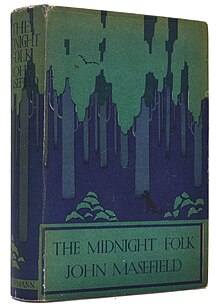 First edition (publ. Heinemann) | |
| Author | John Masefield |
|---|---|
| Language | English |
| Genre | Children's fantasy novel |
| Publisher | Heinemann |
Publication date | 1927 |
| Publication place | United Kingdom |
| Media type | Print (Hardcover and Paperback) |
| Followed by | "The Box of Delights" |
The Midnight Folk is a children's fantasy novel by John Masefield first published in 1927. It is about a boy, Kay Harker, who sets out to discover what became of a fortune stolen from his seafaring great grandfather Aston Tirrold Harker (in reality, Aston Tirrold is a village in Oxfordshire). The treasure is also sought by a coven of witches who are seeking it for their own ends. Kay's governess Sylvia Daisy Pouncer is a member of the coven. The witches are led or guided by the wizard Abner Brown.
Kay Harker is aided in his quest by various talking animals, most notably Nibbins the cat, who used to be a witch's cat but has reformed. There are two other household cats: the main antagonist is Blackmalkin, and he is aided by the mysterious Greymalkin who takes his name from the witch's familiar in the opening scene of Shakespeare's Macbeth.
Kay Harker has various adventures—sailing on the high seas, swimming with mermaids, flying on broomsticks. At one point in the novel he manages to see into the past. Many maternal characters appear in the book; one takes Kay on a nocturnal ride on a magical horse. She then reappears at the end of the book as Caroline Louisa, Kay's new guardian. She tells Kay, "... I loved your mother...". It is possible that she represents Masefield's memory of his own mother who died when he was very young.
Kay's toys (known as "the guards") have been taken away from him at the start of the book, apparently because they will remind him of his parents; there is a strong implication that Kay's parents are deceased. The guards play little part in the main narrative but have a critical role in the final recovery of the treasure.
The Midnight Folk is written as one piece. There are no chapter divisions. Division within the text is obtained by moving from prose to verse or even song in some places.